All the Uno Rules Explained

Many Classpop! Staff writers grew up playing UNO on family game nights with their families, but most still don’t have all of the UNO rules memorized. From how many cards to deal in UNO to UNO rules for the last card, it’s slightly more complex than simple party games like bingo or pin the tail on the donkey. That being said, UNO is one of the most fun games to play with friends and family, and the UNO instructions are easy to follow once you get the hang of them.
If you’re unsure of how to play UNO, you’re probably wondering, "What are the basic rules of UNO?" We’ve compiled the most important UNO rules so you can enjoy the game instead of reading the instruction booklet. After all, according to Piedmont Healthcare, spending time with friends and family is crucial for health and well-being, and games like UNO are great ways to bring everyone together.
Jump to Section
Uno Rules
1. Get to Know the UNO Cards
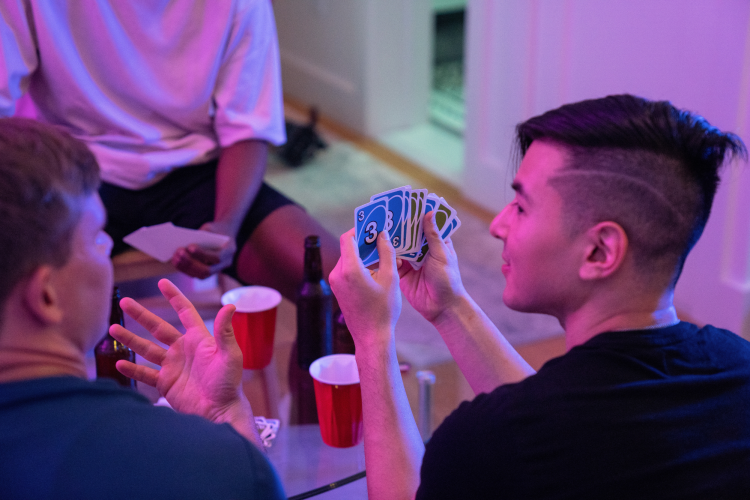
As a brand-new UNO player, you may be eager to get started and not bother reading the UNO rules or studying the cards. You might be thinking, “How hard can it be?” As it turns out, the game isn’t as cut and dried as, say, Go Fish. Unlike standard playing cards, an UNO deck is numbered from zero through nine and features four colors (yellow, green, red and blue) rather than spades, hearts, diamonds and clubs.
You can only place corresponding colors and/or numbers on top of one another. For example, if someone puts down a yellow number seven, you can either play any yellow card or another number seven of any color. The objective of the game is simple: be the first one to get rid of all your cards and score 500 points. UNO is competitive, but like many board games for a party, it’s also great for team building games because it encourages bonding.
There are also a few special cards you’ll want to get familiar with before play begins.
Draw 2 and Draw 4
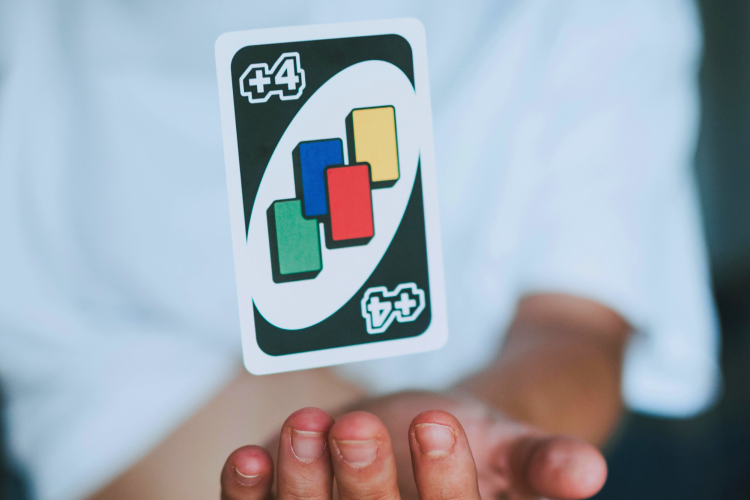
Of all the UNO rules, Draw 4 is the one every player dreads (unless they’re dishing it out, of course). If the player before you puts down a card with a plus sign and the number four on it, you lose a turn and have to draw four cards. UNO rules draw 2 is the same concept, but with just two cards instead of four (how generous!).
Reverse
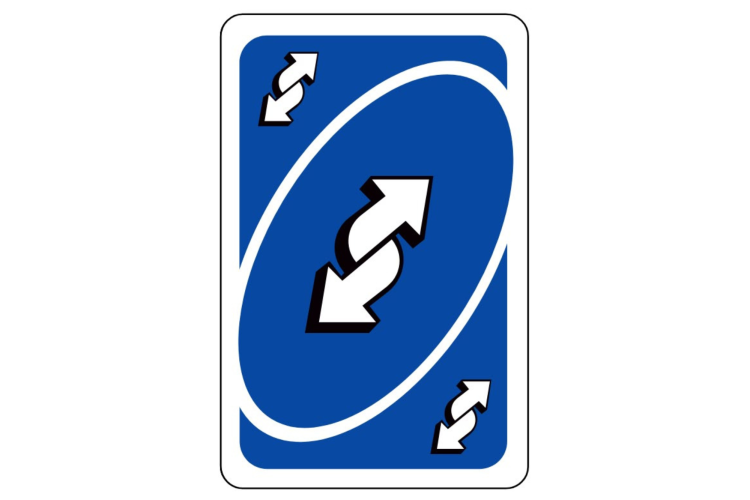
The Reverse card has two arrows pointing in opposite directions, and it’s one of the simplest UNO rules. This card reverses the direction of play, so if you were going clockwise, you’ll now go counterclockwise (or vice versa).
Skip
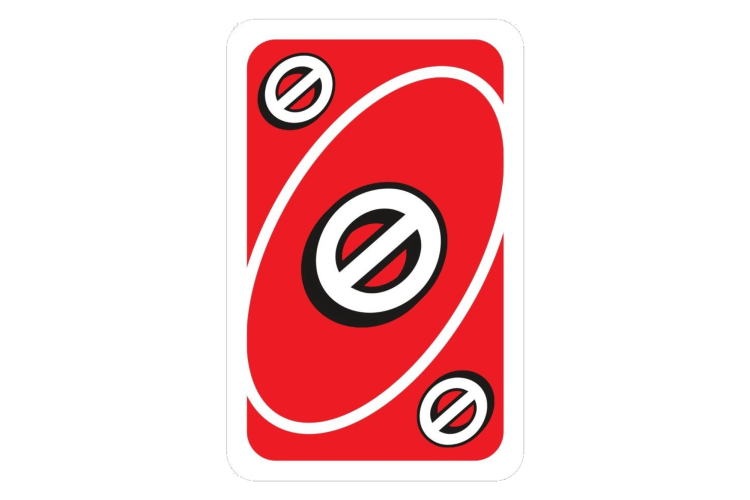
Featuring a circle with a line through it, this card forces the next player to skip their turn. This is one of my favorite uno rules to utilize when I see someone is running out of cards. Buying yourself more time is always a good idea in this game.
Wild Cards
There are two different types of wild cards: regular and Draw 4. Regular wild cards let the player choose the next color. You can use this card even if you have another playable card in your hand. Wild Draw 4 cards are a double doozy, combining all the fun and unpredictability of a wild card with the power and punishment of a Draw 4 card. Just keep in mind that the UNO rules say you can’t put down a Wild Draw 4 card if you have another playable card.
2. Deal the Cards and Decide Who Starts

If you want to know how many cards to deal in UNO, you’re about to find out. Once you’ve familiarized yourself with the deck, it’s time to deal the cards and decide who goes first. In my family, we kept it simple by letting the youngest person start, but you could roll a die instead. Give the deck a good shuffle and give seven UNO cards to each player (face down — no cheating!).
Place the remaining cards face down in a pile that everyone can reach. Then, flip over the first card to get the game started.
3. How To Play UNO
Now that everyone has their UNO cards, it’s officially time to play.
- Each player is dealt seven cards at the start of the game.
- Then, each player will take their turn. If they have a playable card, they can put it down. Remember, a playable card matches either the color or number of the face-up card (unless it's a wild card).
- If no suitable cards exist, the player will take a card from the draw pile and see if it works. The player can play the card they drew immediately, if it's playable. They cannot play any other cards from their hand after drawing and playing a drawn card.
- Players only get one chance to draw per turn, so if the card isn't playable, they must pass and let the next person go.
4. Say "UNO" When You Have One Card Left
When it comes to UNO rules for the last card, most people know to shout “UNO!” when they have only one card remaining. What you may not be aware of, however, is that you must draw four cards if you fail to do this. All isn’t lost if you forget, though. If you catch your mistake before the other players realize, you get off scot-free. On the flip side, if another player doesn’t say "UNO" but their turn has already passed, they face no punishment.
5. Tally Up the Score

As per the UNO rules, a round is over when someone gets rid of all their cards. The first player to accomplish this scores points by adding up the cards left in everyone else’s hands. Number cards are worth their face value, and Reverse, Skip and Draw 2 cards are worth 20 points each. Both types of wild cards are worth 50 points each.
Each subsequent person to exit the game by getting rid of their cards follows the same method of scoring. The first player to reach 500 points wins.
Uno Rules FAQs
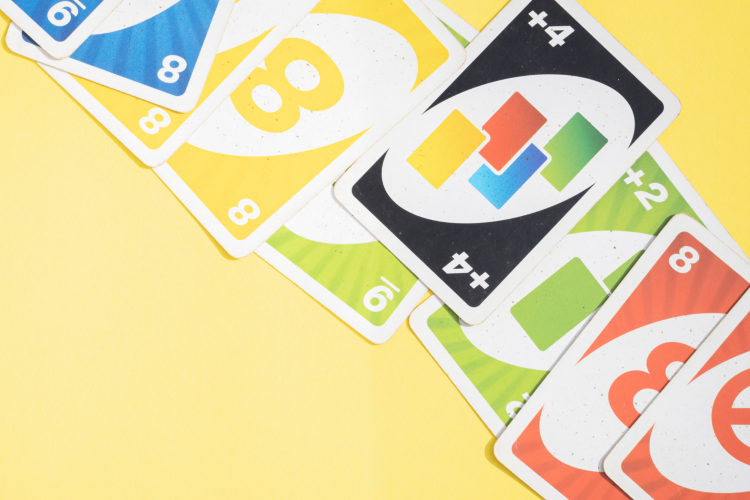
Can You Put a +2 On a +2?
One of the most disheartening UNO rules, stacking Draw 2 cards is not allowed (not officially, at least). While it’s tempting to save yourself and make the next player draw four, according to UNO, that would be cheating.
In general, you can only play one card at a time in UNO, according to the official rules. You can't stack multiple cards of the same number or action cards like Draw Two or Wild Draw Four on top of each other during the same turn. While official rules don't allow stacking, some groups play with house rules that permit it. If you're playing with friends or family, it's a good idea to clarify if you'll be using any house rules that allow stacking before the game begins.
While you can't put down more than two Draw 2 cards at once, you can play a Draw 2 on top of another Draw 2, for example, a red Draw 2 on a blue Draw 2.
What Is The 7 Rule In Uno?
In terms of traditional UNO rules, playing a “7” isn’t anything special. However, there is a popular house rule that allows a player to swap hands with another player of their choosing when a seven is put down.
Can We Put +2 On +4?
You can probably guess where this is going. In the world of UNO rules, stacking Draw 2 and Draw 4 cards is also not allowed. Wouldn’t it be awesome if you could make the next player draw six UNO cards?
Now that you know how to play UNO, you’re ready for a wholesome game filled with fun, laughter and plenty of healthy competition. From simple things like how to win the game to more complex UNO instructions like UNO rules for Draw 2 and UNO rules for Draw 4, this guide prepares you to go into each round with confidence. Whether you choose to follow the UNO rules or bend them a little, you can rest assured you’ll always be prepared to play.
For even more fun ways to bring family and friends together, check out other experiences happening on Classpop!

